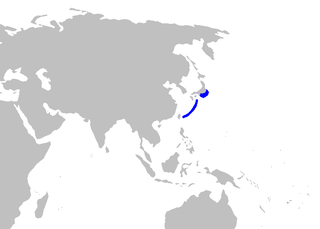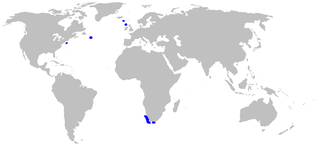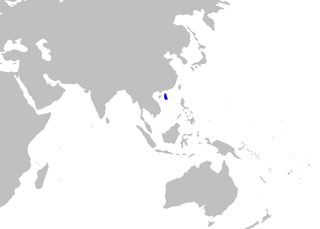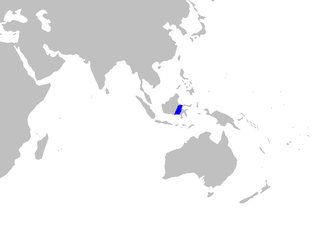
The brown catshark is commonly found in the Pacific Ocean, ranging from the northern Pacific waters off the coast of British Columbia and south to the Baja California peninsula in Mexico. They may live as far south as Ecuador and Peru. Brown catsharks are deep-water sharks that live on the outer continental shelf and the upper slope. They have been known to live at depths ranging from 30 to 650 m and live on the bottom, usually in muddy or sandy areas. The brown catshark, when originally described, was called Catulus brunneus.

Apristurus is a genus of catsharks, the family Scyliorhinidae, commonly known as the ghost or demon catsharks.

The humpback cat shark is a cat shark of the family Scyliorhinidae in the order Carcharhiniformes, found in the northwest Pacific Ocean off Zhujiang, South China Sea, from the surface to 915 m. Its length is 39–41 cm. The largest specimen examined by Nakaya and Sato was 54.2 cm TL. The humpback catshark is a little-known oviparous deepwater catshark.
The deepwater catshark is a catshark of the family Scyliorhinidae, found in the western Atlantic from Delaware Bay to Suriname, and in the eastern Atlantic from Morocco to northwest Africa. An important key factor to understanding these creatures is ageing, many deepwater Apristurus profundorum have poorly calcified vertebrae that lack visible growth bands, and most do not have dorsal fin spines that can be used for ageing. Other methods, such as captive growth and tag-recapture, are also limited in their suitability for deepwater chondrichthyans due to difficulties in the deep sea.

The longfin catshark is a catshark of the family Scyliorhinidae found in the western Pacific from Japan to the Philippines, and the East and South China Seas, and the Kyūshū-Palau Ridge, at depths between 530 and 865 m. Its length is up to 48 cm.

The shortnose demon catshark is a catshark of the family Scyliorhinidae found only in deep water in the East China Sea. Its length is up to 40 cm. A. internatus is known only from the holotype and a paratype, both caught in the East China Sea, probably taken as bycatch in deepwater trawl fisheries. The reproduction of this catshark is oviparous.

The Japanese catshark is a catshark of the family Scyliorhinidae, found in the northwest Pacific off Chiba Prefecture, Honshū, Japan, between 36 and 34°N. This shark has a relatively slender body, with the trunk tapering towards the head. Its snout is moderately long, bell-shaped, and broad; the preoral snout is about 7 to 8% of total its length. It has large gill slits, rather small eyes in adults, nostrils fairly broad, and a long broad, arched mouth. It is commonly taken by trawl off the type locality, and possibly used for oil, human consumption, and fishmeal or fish cakes locally.

The Iceland or Icelandic catshark is a species of catshark, belonging to the family Scyliorhinidae. This catshark is found in the western Atlantic, from Massachusetts, Delaware, and the northern Gulf of Mexico, as well as the eastern Atlantic from Iceland, southwestern Ireland, the Canary Islands, Madeira, South Africa, and between 67 and 11°N. They are found in depths of 550 to 1450 meters near or at the bottom over upper continental slopes.

The Panama ghost catshark is a lesser known catshark of the family Scyliorhinidae. This catshark is only found off Panama, between 9°N and 2°N. The reproduction of the Panama ghost shark is oviparous.

The South China catshark is a catshark of the family Scyliorhinidae, known only from the holotype, which was taken from the South China Sea at a depth of 537 m. Its length is 42 cm, but this measurement was taken from an immature specimen. The reproduction of the South China catshark is oviparous.

The Saldanha catshark is a species of catshark, belonging to the family Scyliorhinidae. This catshark is found from Cape Columbine to south of False Bay in South Africa, between 31 and 40°S. Its length is up to 88 cm. It is a plain, dark grey-brown, stout catshark, with moderately large eyes, a broad snout, and large pectoral fins.

The largenose catshark is a catshark of the family Scyliorhinidae. The largenose catshark is found on the upper continental slopes in the eastern Pacific, from the Gulf of Panama to Ecuador and central Chile, between 9°N and 28°S. It can grow up to 70 cm. Its reproduction is oviparous. This nose shark is considered to be a harmless species. It is known to originate from the Gulf of Panama, Ecuador, and Central Chile.

The smalleye catshark is a catshark of the family Scyliorhinidae, found in the southeast Atlantic at depths between 700 and 2,000 m. It can grow up to 61 cm. The reproduction of this catshark is oviparous.

The smalldorsal cat shark is a catshark of the family Scyliorhinidae found in the South China Sea, at depths to 915 m. It can grow up to 37 cm. A. micropterygeus is unique among its species in having a narrow and sharply pointed first dorsal fin. However, Nakaya and Sato (2000) recommended that the status of the species be reviewed once additional specimens are available, citing the possibility that the dorsal fin of the holotype may have been malformed. The reproduction of the smalldorsal catshark is oviparous.

The pale catshark is a rare catshark of the family Scyliorhinidae. The holotype,the only specimen, was found on the Makassar Strait slope at a depth of 655 m. Its length is around 21 cm, although this measurement was taken from a juvenile specimen. The reproduction of the pale catshark is oviparous.

The broadnose catshark is a catshark of the family Scyliorhinidae, the holotype and only specimen being found in deep water in the Andaman Sea in the Indian Ocean between 16 and 10°N. Its length is around 26 cm, although this measurement was taken from an immature specimen. The reproduction of this catshark is oviparous. The threats are not exactly known but it may be deepwater fisheries.

The longnose catshark is a catshark of the family Scyliorhinidae found in the eastern central Pacific from central and southern California and the Gulf of California, between latitudes 38° N and 23° N, at depths down to 1,890. Its length is up to 58 cm.

The broadmouth catshark is a rare catshark of the family Scyliorhinidae, the holotype and only specimen of which was taken from off Zhujiang in the South China Sea, at a depth of 913 m. Its length is around 38 cm. The broadmouth catshark's reproduction is oviparous. Considering the species is not well known, the threats are not known either but may be deepwater fisheries.

Fedorov's catshark is a catshark of the family Scyliorhinidae. This shark has oviparous reproduction. This is a very poorly known species, with less than 30 specimens reported in the scientific literature. Almost nothing is known of its biology. This species may be endemic to northern Japanese waters, where it is taken in water around 1,200 m deep. However, accurate identification of Apristurus species is particularly difficult, and further research is required to determine its geographical and bathymetrical distribution.



















